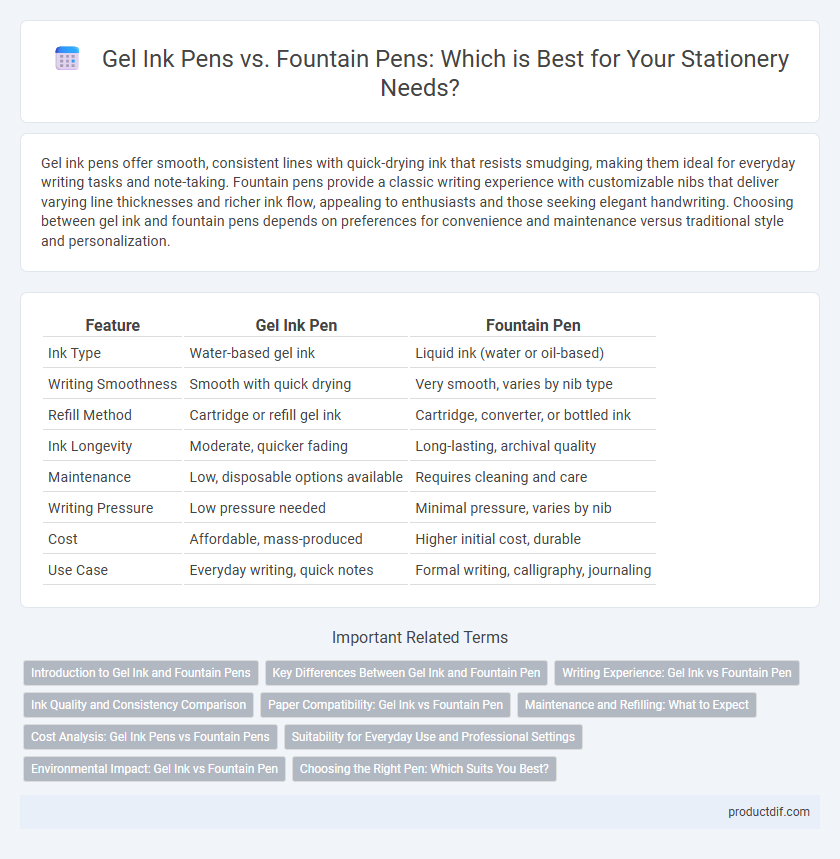Gel ink pens offer smooth, consistent lines with quick-drying ink that resists smudging, making them ideal for everyday writing tasks and note-taking. Fountain pens provide a classic writing experience with customizable nibs that deliver varying line thicknesses and richer ink flow, appealing to enthusiasts and those seeking elegant handwriting. Choosing between gel ink and fountain pens depends on preferences for convenience and maintenance versus traditional style and personalization.
Table of Comparison
| Feature | Gel Ink Pen | Fountain Pen |
|---|---|---|
| Ink Type | Water-based gel ink | Liquid ink (water or oil-based) |
| Writing Smoothness | Smooth with quick drying | Very smooth, varies by nib type |
| Refill Method | Cartridge or refill gel ink | Cartridge, converter, or bottled ink |
| Ink Longevity | Moderate, quicker fading | Long-lasting, archival quality |
| Maintenance | Low, disposable options available | Requires cleaning and care |
| Writing Pressure | Low pressure needed | Minimal pressure, varies by nib |
| Cost | Affordable, mass-produced | Higher initial cost, durable |
| Use Case | Everyday writing, quick notes | Formal writing, calligraphy, journaling |
Introduction to Gel Ink and Fountain Pens
Gel ink pens utilize pigment-based ink suspended in a water-based gel, offering smooth, vibrant lines with quick-drying properties ideal for detailed writing and artistic applications. Fountain pens use a nib and feed system to draw water-based liquid ink from a reservoir, producing varied line widths and a classic writing experience preferred by enthusiasts and professionals. Both pen types provide unique tactile feedback and ink characteristics that cater to different writing preferences and tasks.
Key Differences Between Gel Ink and Fountain Pen
Gel ink pens use water-based gel ink that offers smooth, vibrant lines with quick drying times, making them ideal for everyday writing and note-taking. Fountain pens utilize liquid ink stored in a reservoir, delivering a customizable flow and elegant writing experience favored by calligraphy enthusiasts and professionals. The main differences lie in ink composition, writing feel, maintenance requirements, and longevity, with gel pens requiring less upkeep and fountain pens often providing superior durability and refill flexibility.
Writing Experience: Gel Ink vs Fountain Pen
Gel ink pens deliver smooth, consistent lines with quick-drying ink that reduces smudging, ideal for everyday writing and note-taking. Fountain pens provide a more personalized writing experience with variable line thickness, fluid ink flow, and ergonomic design that reduces hand fatigue during extended use. Writers often prefer gel ink for precision and convenience, while fountain pens are favored for elegance and expressive strokes.
Ink Quality and Consistency Comparison
Gel ink offers vibrant, consistent lines with smooth flow and quick drying times, making it ideal for everyday writing and detailed work. Fountain pen ink provides a richer, more nuanced color variation and a fluid writing experience, though it may require higher maintenance and longer drying times. Both ink types excel in quality, but gel ink prioritizes uniform consistency while fountain pen ink emphasizes expressive line variation.
Paper Compatibility: Gel Ink vs Fountain Pen
Gel ink pens offer superior compatibility with a wide range of paper types, including low-quality, absorbent, and textured surfaces, as their quick-drying ink resists smudging and bleeding. Fountain pens require high-quality, smooth, and heavier paper to prevent feathering and ink bleed-through, often needing specialized or premium papers like Rhodia or Clairefontaine. Choosing the appropriate pen depends on the paper's weight, texture, and coating to ensure optimal ink performance and writing clarity.
Maintenance and Refilling: What to Expect
Gel ink pens require minimal maintenance, usually just occasional refilling with gel ink cartridges or replacing the entire pen. Fountain pens demand more care, including regular cleaning of the nib and feed to prevent clogging and ensure smooth ink flow. Refilling a fountain pen involves either using bottled ink with a converter or inserting disposable cartridges, both requiring careful handling to avoid spills and maintain pen longevity.
Cost Analysis: Gel Ink Pens vs Fountain Pens
Gel ink pens typically cost between $1 to $10 per unit, offering affordability for daily use and disposable options, while fountain pens range from $15 to several hundred dollars due to their durable construction and refillable cartridges. The long-term expense of fountain pens can be lower because of reusable ink cartridges and replaceable nibs, although initial investment is higher compared to gel ink pens. Stationery enthusiasts often weigh these cost differences against maintenance and writing experience when selecting between gel ink and fountain pens.
Suitability for Everyday Use and Professional Settings
Gel ink pens offer smooth writing and quick-drying ink, making them highly suitable for everyday use and fast note-taking in professional settings. Fountain pens provide a classic, elegant feel with customizable nibs, preferred for formal documents and signatures but require more maintenance, limiting their convenience for daily tasks. Choosing between the two depends on balancing ease of use and the desired level of sophistication in a professional environment.
Environmental Impact: Gel Ink vs Fountain Pen
Gel ink pens typically use plastic cartridges that contribute to non-biodegradable waste, increasing environmental pollution and landfill burden. Fountain pens, with refillable ink reservoirs and durable construction, significantly reduce disposable waste and resource consumption over time. Choosing fountain pens supports sustainable stationery practices by minimizing single-use plastic and promoting long-term use.
Choosing the Right Pen: Which Suits You Best?
Gel ink pens offer smooth, consistent lines and quick-drying ink ideal for daily writing and note-taking, while fountain pens provide a classic, elegant writing experience with customizable nibs and ink colors, appealing to enthusiasts and professionals. Consider gel ink pens for convenience, low maintenance, and vibrant ink performance, whereas fountain pens suit users seeking precision, personalization, and a more traditional feel. Your choice depends on writing style, frequency, and the importance of ink aesthetics in your stationery collection.
Gel Ink vs Fountain Pen Infographic

 productdif.com
productdif.com